- Part 5 of a series on Rotterdam’s efforts to become a sustainable and “climate-proof” city.
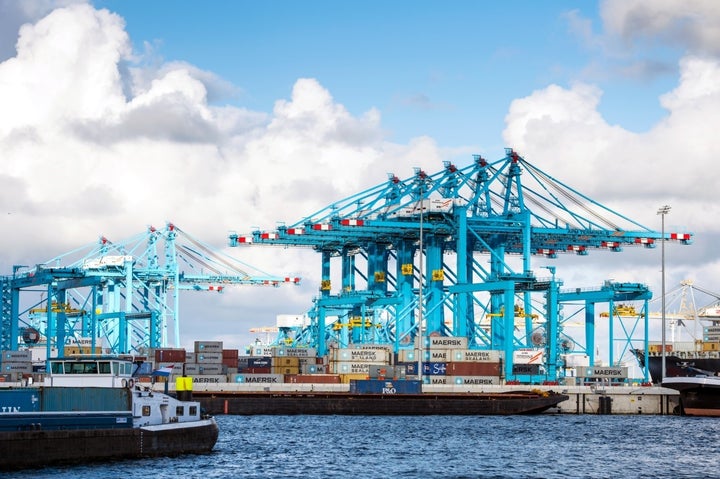
Cranes in the Port of Rotterdam’s APS Terminal in the newly created Maasvlatke II port expansion area
Rotterdam, The Netherlands— Rotterdam’s Port Authority has announced it intends the Port of Rotterdam to become Europe’s most sustainable and efficient port, despite a recent major increase in coal power production there. This will be a big challenge.
The port is Europe’s largest by cargo volume and covers 48 square miles of land and water. Millions of tons of fossil fuels per year are transshipped from the port, and it hosts many energy-intensive industries. Among them are two legacy 500 MW coal power plants that have been operating since the late 1980s.
While these two old power plants are scheduled to close by early 2017, two new and much larger coal power plants totaling 1,870 MW opened in the port in 2015. Together they generate 9.7 million tons of CO2 per year, about 50 percent more than the two older plants.
That conflicts with the port’s stated environmental goals. “The Port of Rotterdam has the ambition of being the most sustainable port in the world,” the city’s Climate Initiative website notes. According to the port’s website, it is officially committed to reducing its CO2 emissions by 20% in 2020, 50% in 2030, and 80% in 2050. How this will be done is not clear.
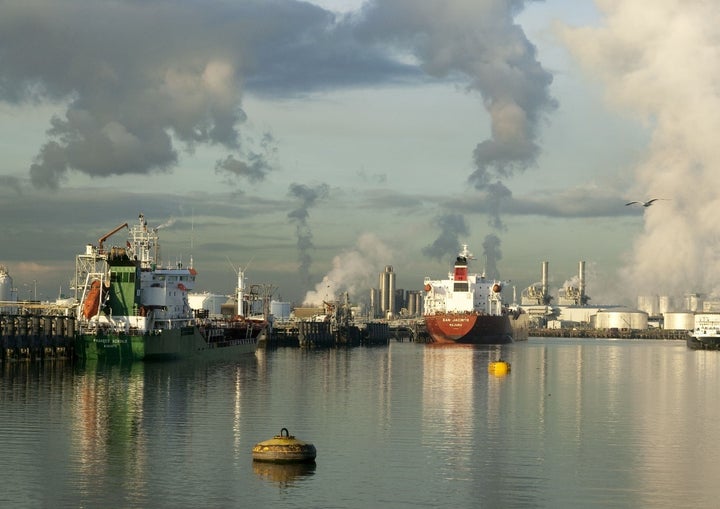
Ships berthed in the Port of Rotterdam with refineries and fuel storage tanks in the background.
Most of the emissions reductions were supposed to have come from an experimental and commercially unproven technology known as Carbon Capture and Storage (CCS). While it had been used to reinject CO2 from Norwegian oil field operations, no largescale CCS had ever been proven to be technologically and commercially viable for a large coal-fired power plant.
The larger of the port’s two new coal plants, Uniper-Maastvlatke 3, is a 1,070 MW coal plant that has a CCS unit, but it has not yet begun to operate and at best is only designed to capture 25 percent of the plant’s CO2 emissions. The other new coal power plant is not CCS-ready.
Rotterdam’s Climate Ambitions
In November 2006, the city and port’s International Advisory Board, comprised of business leaders, advised the port and the industry operating there to begin taking action to insure their economic future and seize potential economic opportunities by transitioning away from fossil fuels.
The message was reinforced in a visit to Rotterdam by former President Bill Clinton in December 2006. The city took note and in May 2007 adopted the Rotterdam Climate Initiative, pledging to cut the city’s carbon emissions in half by 2025.
Despite warnings from environmental researchers about the risks of depending on unproven CCS technology, city and port officials allowed the two new coal plants to be built on the theory that their emissions would be trapped by CCS and reinjected into depleted oil and gas fields beneath the North Sea. The port’s commitments to steeply reduce emissions and the reality of its rising emissions are now sharply at odds.
However, according to Chris Roorda, senior researcher with the Dutch Research Institute for Transitions (DRIFT), “The ambition of the Rotterdam Climate Initiative was always based on the idea that despite the initiative, the city's CO2 emissions would increase inexorably, although more slowly than under business-as-usual conditions. Then CCS would magically come to the rescue and painlessly eliminate vast amounts of emissions. But, of course, industry in the port is not investing in CCS, because it is far too expensive and uncompetitive.”
In the wake of disillusionment about the availability of cost-effective CCS technology, Rotterdam—to environmentalists’ chagrin—recently abandoned the Rotterdam Climate Initiative’s much-vaunted official commitment to reduce its carbon emissions 50 percent by 2025.
Political opponents have attacked the Initiative for investing municipal funds to address global issues. Instead, they contend that investment should be restricted to cost-effective measures that produce tangible benefits for residents, such as cleaner air, lower energy bills, less noise, and flood protection.
Carbon Capture and Sequestration (CCS)
CCS has not as yet been shown to be commercially competitive in the power industry, nor has it been proven at the large scale needed to capture all the emissions of a large coal power plant.
Significant amounts of a thermal power plant’s energy are required to compress and store its CO2 emissions and subsequently transport and monitor them indefinitely to prevent their leakage or other release from storage. Another problem is that CCS technology typically does not capture all of the emissions a thermal energy plant produces, so some greenhouse gases are released.
The ROAD Project
The port does have plans—subsidized by hundreds of millions of euros of public funds—for a two-year CCS pilot project in which a quarter of Uniper-Maastvlatke 3’s emissions will be sequestered using a regional CCS pipeline now being developed.
Known as the Rotterdam Capture and Storage Demonstration Project (ROAD), it is one of the world’s largest CCS demonstration efforts and is designed to link industries producing lots of CO2 to potential offshore CO2 storage facilities.
In addition to the challenge of its coal power plant emissions, the Port of Rotterdam has the largest terminal for coal and iron ore in Western Europe. Millions of tons of coal are transshipped from here every year, and fossil fuels still account for half of all the port’s cargo. The port is home to natural gas terminals, chemical and petrochemical companies as well as many other industries.
Nonetheless, Rotterdam is actively trying to position itself for the inevitable end of the fossil-fuel era, according to port’s Director for Energy and Industry Nico van Dooren. Van Dooren projects that the port will reduce its reliance on fossil fuels in the future.
Currently, however, the port’s modest sustainability efforts are largely focused on improvements in energy efficiency and reuse of materials and wastes by companies in the port, as well as co-firing some biomass in a coal plant.
The port also has 200 MW of installed wind power and much smaller solar generating capacity. Officials at the port recognize that these current measures, however, are not yet enough to make the port sustainable.
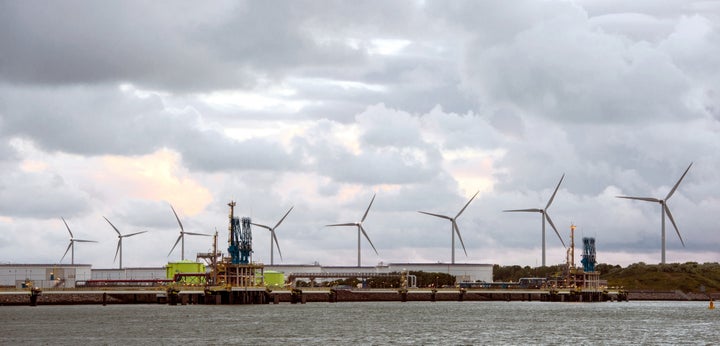
Wind turbines behind gates of LNG Terminal at Maastvlatke, Port of Rotterdam.
A Call for National Climate Action
The port recently organized more than 40 large companies in the port—including Siemens, Shell, Eneco, and the Port Authority itself—to issue a common declaration in support of the 2015 global Paris Climate Accord. (The accord, signed by 194 nations and the EU, and recently ratified by 96 countries accounting for two-thirds of the world’s carbon emissions, seeks to keep global temperature increase to less than 2°C and less than 1.5°C if possible.)
The port’s business coalition also has called on the Netherlands’ government to accelerate the nation’s transition away from fossil fuels to renewable energy. Its October 25, 2016 declaration urges the government to create a long-term policy framework that will lead to an 80-95 percent reduction in the country’s greenhouse gas by 2050 (compared with 1990) and create legislation to implement the Paris accord.
It further asks the government to establish interim emission-reduction milestone goals for 2030 and 2040 and an independent climate authority with power to consistently enforce climate policy “irrespective of which government is in power.”
To further ensure national energy policy cohesion, the coalition also urged that the post of minister for economy, climate and energy be created and that a national investment bank be set up to support innovation and major energy projects.
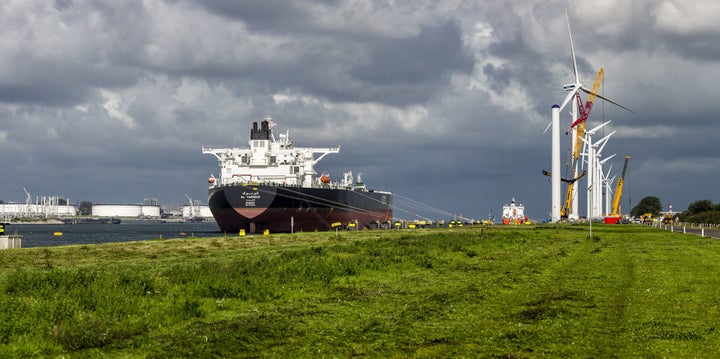
Wind turbines and Kuwaiti oil tanker Al-Yarmouk at the Port of Rotterdam's Calandkanaal.
Changing Direction
The forthright and unprecedented demand for more effective climate action comes as the Netherlands lags other European nations in moving toward clean energy. The nation today is dependent on fossil fuels for some 94 percent of its energy. Rotterdam is one of the largest sources of CO2 in Europe, similar to the heavily industrialized Ruhr region in Germany.
The port is a huge contributor to the city’s economy and adds more than €14 billion in direct value to the Rotterdam region. Companies in the port directly employ over 94,000 people, and the port stimulates €2 billion of investment annually into the city’s economy. But in so doing, the port’s industries produce nearly 90 percent of Rotterdam’s CO2 emissions.

A hybrid diesel-electric tugboat, E-Kotug, being tested by Port of Rotterdam in an effort to reduce shipping emissions and improve and air quality.
Major Challenges Ahead
It would be challenging enough to curtail the port’s emissions if the port were not also growing. But the port is nearing capacity. The number of ocean-going ships docking at Rotterdam is expected to rise from 31,000 a year in 2006 to 57,000 in 2033 while the number of inland vessels will increase from 28,000 currently to nearly 70,000.
The Port Authority therefore is currently completing a new deep water harbor and industrial area called Maasvlakte 2, on land reclaimed from the North Sea, at a cost of nearly €3 billion. The port describes the Maasvlakte 2 expansion on the Rotterdam Climate Initiative’s website as a part of its sustainability transformation.
“By breaking new ground in the way it operates, which includes the development of the Second Maasvlakte, the port of Rotterdam wants to be at the forefront of sustainability and accessibility,” the website states.
The Port has set environmental requirements for companies wishing to locate at Maasvlakte 2. These criteria cover air quality, noise, energy efficiency and reuse of waste heat and materials as well as use of cleaner transport inland beyond the port.
This October, a company called Sif that makes masts for offshore wind turbines opened a new facility at Maasvlakte 2. “Maasvlakte 2 gives us the capacity to accommodate these new developments,” a port spokesman said.
The Maasvlakte 2 container terminals are also fully electric, with the terminal of APM Terminals entirely powered by wind turbines. Meanwhile the Rotterdam World Gateway buildings are equipped with thermal energy storage.
Maasvlakte 2 has been accepting tenants since 2013 and will eventually more than double Rotterdam’s container capacity while providing more space for chemical and distribution industries, as well as for large-scale container storage. The expansion thus makes it imperative for the port to find ways to reduce air pollution and CO2 emissions.
Fossil Fuel Giants in Port
Royal Dutch Shell operates one of Europe’s largest oil refineries in the port of Rotterdam where it processes 450,000 barrels of oil a year. It will contribute waste heat to district residential heating and to a heat storage complex.
About 300,000 tonnes of pure CO2 produced here and at Alco Energy’s biofuels plant is sent to the Westland area north of the port where it is used as a nutrient to increase plant productivity in the area’s large greenhouse district.
By getting the CO2 from the port, market gardeners reduce their natural gas by 95 million cubic meters a year and their CO2 emissions by 170,000 tons. (Natural gas would otherwise be burned to produce CO2 to stimulate plant growth.) But the CO2 produced and sent to the greenhouses is not permanently sequestered.
Exxon, too, has a major refinery in the port and plans to invest $1 billion in producing lower sulfur fuel and in increasing the refinery’s energy efficiency. BP also has operations in the port. As one indicator of the hazards that large concentrations of fossil fuels can present, BP offices are behind an earthen berm that serves as a blast deflector.
Apart from its planned pilot carbon sequestration efforts, the port is striving to increase the production of renewable energy by expanding its wind and solar production and by increasing the efficiency with which energy is used in the area.
Klosterboer, a large cold storage and distribution company at the port has installed an 1,800 panel rooftop solar system capable of producing 430 MWh of power annually and installing wind turbines. By 2023, several companies plan to have a total of 4,450 MW of wind power in the Dutch part of the North Sea, according to a port spokesman.
Meanwhile on land, energy-conscious Klosterboer is the first cold storage firm to receive a Lean & Green award. Its automated warehouses use 37-45 percent less power than conventional warehouses. The company also uses energy-efficient LED lighting throughout its facilities and received a BREEAM-NL three-star certification for the construction of its new terminal.
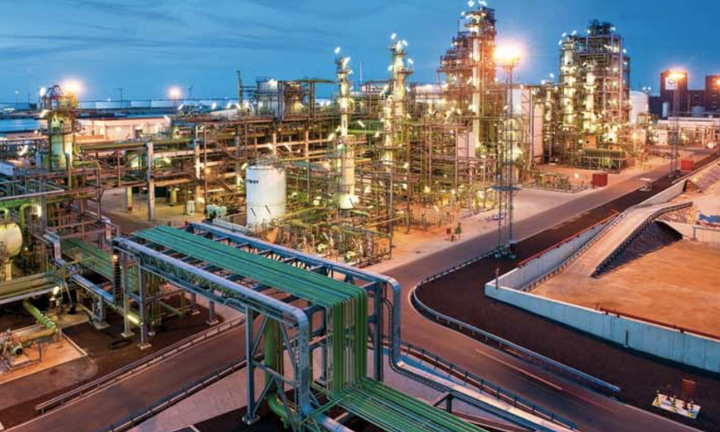
Europe’s largest renewable biofuels plant operated by Neste Oil in Rotterdam's harbor and industrial area. Neste is currently building a € 60 million biopropane production unit that is expected to be operational by 2017.
Alternative Fuels
LyondellBasell, one of the world’s largest plastics, chemicals, and refining companies and a port tenant, is entering the biofuel business by making ETBE (ethyl tertiary butyl ether) from plant oil feedstock. Plant-based fuels have the potential to reduce net carbon emissions because their carbon has been extracted from the atmosphere by the plant during photosynthesis. Thus if their carbon emissions are captured and sequestered, a drawdown of atmospheric carbon can in theory occur.
Another port tenant, Alco Energy (formerly the now-bankrupt Abengoa, the Spanish renewable energy and desalinization company), is engaged in manufacturing corn ethanol at its Rotterdam plant.
To reduce the emissions of barges sailing from the port of Rotterdam to the hinterland of Europe and the emissions of vehicles driving in the port complex, the port has built an LNG terminal where LNG is gasified with the help of waste heat from the port’s new Uniper coal power plant.. According to a port spokesman, vehicles in the port will at some point be able to run either on LNG, renewably generated hydrogen, electricity, or by using hybrid electric propulsion.
Currently, only a few inland barges and some cruise ships are using LNG, as it is more expensive than other fuels. “But as it is much cleaner and produces less CO2,” port spokesman Sjaak Poppe said. “We think LNG is important as a transition fuel, especially for shipping in the next decades,” he added.
In an effort to increase the production of renewable energy, the port is planning on raising its wind power capacity to 300 MW and is conducting an experiment with a small floating solar power plant. According to a port spokesman, the lake where the experiment is taking place has space for 400,000 panels. That would be able to produce enough energy for 25,000 households.
To further reduce the port’s reliance on fossil fuels, the port is also encouraging companies that produce biofuels to locate in the port. Neste, SkyNRG, and KLM are cooperating to jointly produce biofuels for aviation in the port. Neste itself produces 1 million tonnes of biofuels annually in Rotterdam, not all for aviation fuel.
Neste is trying to get KLM to adopt its biokerosene aviation fuel as a 1 percent blend in all KLM’s jet fuel. Although these quantities are small relative to global demand for aviation fuel, the effort is important because it is currently the only viable alternative to fossil fuel-derived kerosene.
Despite the totality of all efforts made to date by individual companies, the port from 2005-2012 merely held its CO2 emissions constant and made little progress in ramping up renewable energy production. Over the past four years, however, the port’s wind capacity has increased significantly and the port is planning to provide 14 percent of its power from all renewable sources by 2030.
This concludes Part 5 of a five-part series on Rotterdam’s efforts to become a more sustainable city. The other parts of the series are:
4. The “Climate-Proofing” of Rotterdam (forthcoming)
Additional articles about similar activities elsewhere in Europe can be found at http://www.huffingtonpost.com/author/johnjberger1-422.
John J. Berger, PhD. (www.johnjberger.com) is an energy and environmental policy specialist who has produced ten books on climate, energy, and natural resource topics. He is the author of Climate Peril: The Intelligent Reader’s Guide to the Climate Crisis, and Climate Myths: The Campaign Against Climate Science, and is at work on a new book about climate solutions.
Follow John J. Berger on Twitter: www.twitter.com/johnjberger
